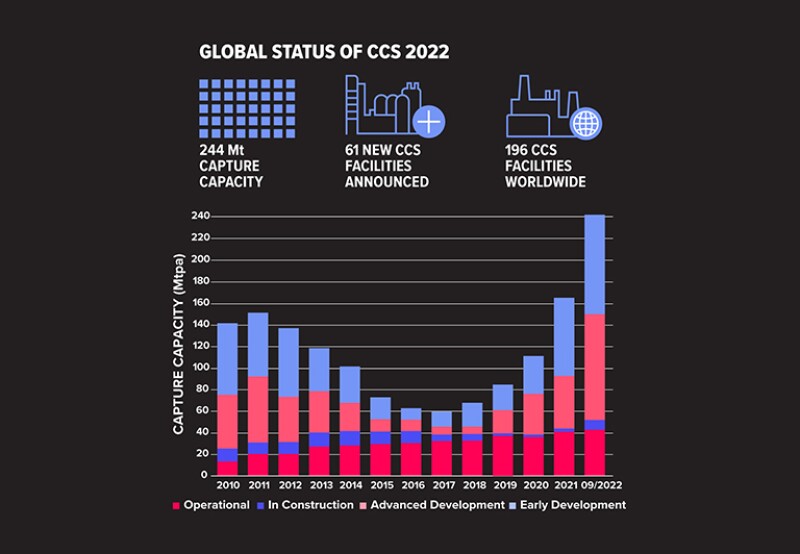CCS projects “accelerated” in 2022 with the CO2 capture capacity of all CCS facilities under development growing 44% over the past 12 months, bringing the total capacity of those projects to 244 mtpa of CO2.
In a report released in mid-October, the Global CCS Institute said 61 new facilities were added to the project pipeline in 2022 for a current tally of 30 projects in operation, 11 under construction, and 153 in development.
The Americas, especially North America, lead the world in CCS deployment. Recent US and Canadian governmental incentives were cited by the Institute in a regional overview.
The US Inflation Reduction Act of 2022 includes enhancements to Internal Revenue Service Section 45Q and $369 billion in funding for climate and energy. The legislation extends the start of construction timing to the end of 2032; lowers capture thresholds, including direct pay; and expands transferability. The US Infrastructure Investment and Jobs Act includes more than $12 billion to be spent on CCS over the next 5 years.
Canada’s 2022 federal budget includes an investment tax credit: the credit rate is 60% for direct air capture projects, 50% for all other carbon capture projects, and 37.5% for transportation, storage, and use from 2022 to 2030. From 2031 to 2040, the tax rates drop to 30%, 25%, and 18.75%.
The boost in activity is reflected in recent CCS‑related updates reported in JPT:
- ExxonMobil joined CF Industries and EnLink in a blue ammonia project in Louisiana that could capture and store 2 million metric tons of CO2 starting in 2025.
- Technip Energies signed a letter of intent to design and build a large-scale floating storage and injection hub offshore Australia. It would be the world’s first, since to date, offshore carbon capture and storage projects use pipelines to transport CO2 to injection sites.
- Equinor and Wintershall Dea have agreed to develop a comprehensive CCS supply chain system connecting Germany with CSS storage on the Norwegian Continental Shelf.
- Texas and Louisiana are stepping up efforts to assume regulatory authority for an emerging wave of CCS projects.
- In October, Canada released draft guidelines on how new oil and gas projects should demonstrate “best-in-class” greenhouse gas emissions performance.
SPE’s CO2 Storage Resources Committee, under the SPE Carbon Dioxide Capture, Utilization, and Storage Technical Section, published Storage Resources Management System (SRMS) Guidelines to support the commercialization of CO2 storage. Released in September, the guidelines include suggestions for the application of the SRMS with the intent of including details of the processes of quantification, categorization, and classification of storable quantities so that the subjective nature of subsurface assessments can be consistent between storage resource assessors.
The role of petroleum engineers in achieving technically sound results in energy transition projects of all kinds was highlighted during a presentation at the SPE Annual Technical Conference and Exhibition by Josh Etkind, global upstream deepwater digital transformation manager for Shell, and Rita Esuru Okoroafor, assistant professor, Texas A&M University, Harold Vance Department of Petroleum Engineering. In their presentation in the SPE Pavilion, “Transferable Skills: Petroleum Engineering and Geoscience Skills Are Shaping the Low-Emission Energy Transition,” they shared a chart showing the core oil and gas-related technical skill sets required for low-emission energy technologies.
Etkind and Okoroafor emphasized the opportunities offered by the technologies shown in the chart below for upstream petroleum engineers and young engineers entering the industry. Looking only at CCS, the Global CCS Institute’s call for the growth of global CO2 storage to “billions of tons per year to meet climate targets” from the current 40 mtpa also points to a growing need for the relevant skills and technical knowledge.



